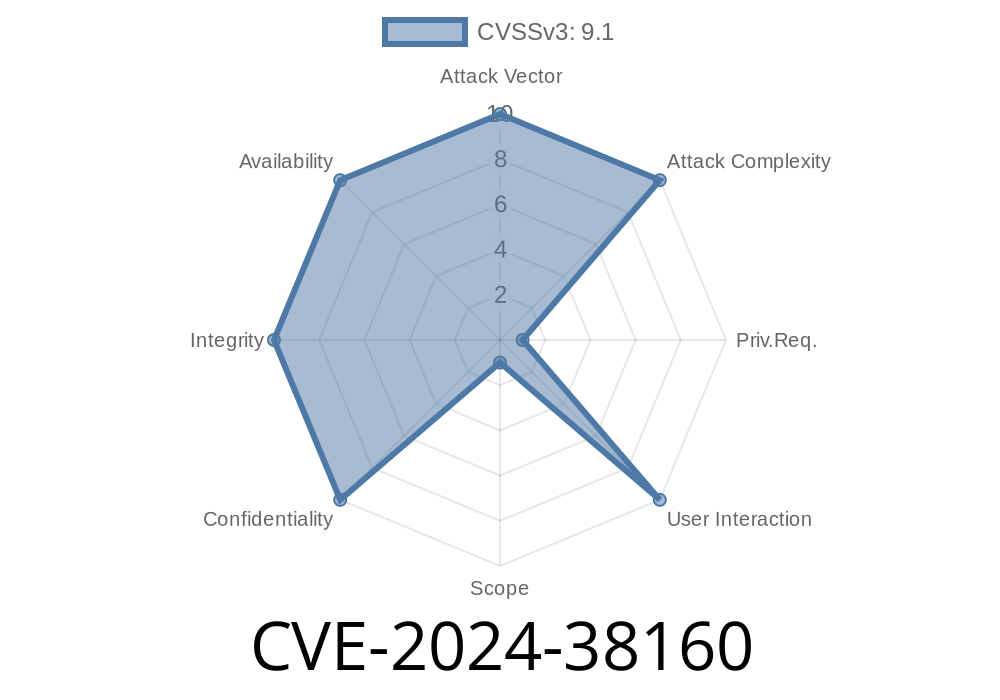Microsoft Windows is the most popular and widely used operating system globally. cyber security threats keep expanding, and as such, Microsoft Windows is consistently a primary target for cyber attacks. Microsoft released a security patch resolving a critical vulnerability, dubbed CVE-2024-38160, in Windows Network Virtualization, which could allow an attacker to remotely execute malicious code on vulnerable systems.
In this post, we'll take an in-depth look at CVE-2024-38160 by exploring the background, diving into a code snippet, and discussing the exploit details. We'll also provide references to original sources for further reading.
Background
CVE-2024-38160 is a remote code execution (RCE) vulnerability affecting Windows Network Virtualization, a feature that enables the virtualization of networks to make them more flexible and scalable, allowing easier management of network resources. The vulnerability exists in the way the Windows Network Virtualization service does not properly validate user-supplied data. This could allow an attacker to execute malicious code on a vulnerable system.
Original references and acknowledgements
The vulnerability was discovered by security researchers and responsibly reported to Microsoft. Microsoft then released a security update addressing this vulnerability. Here are some references for further reading:
- Microsoft Security Advisory - Contains details about the updates released for this vulnerability
- National Vulnerability Database - An extensive overview of the vulnerability, including affected versions, CVSS scores, and references
- CVE-2024-38160 on Github - A public repository providing proof-of-concept code and detailed information related to the vulnerability
Code snippet
The following code snippet demonstrates a simplified version of the vulnerability, specifically showing the improper validation of user-supplied data:
#include <stdio.h>
#include <string.h>
// Windows Network Virtualization service function
void vulnerable_function(char *input_data) {
char buffer[256];
strcpy(buffer, input_data); // <- This is where the vulnerability occurs
printf("Processed data: %s\n", buffer);
}
int main(int argc, char **argv) {
if (argc < 2) {
printf("Usage: %s <input_data>\n", argv[]);
return 1;
}
vulnerable_function(argv[1]);
return ;
}
In the above code, the vulnerable_function() does not adequately validate the data before copying it to the buffer. If the attacker provides a sufficiently large input, it may cause a buffer overflow, leading to remote code execution.
Exploit details
To exploit the CVE-2024-38160 vulnerability, an attacker can craft a malicious packet containing a large amount of data and send it to a target system running Windows Network Virtualization. The data will trigger a buffer overflow, allowing the attacker to inject shellcode that can remotely execute arbitrary code on the target system.
To mitigate this vulnerability, users are advised to apply the corresponding security update provided by Microsoft. This will ensure that systems are adequately protected against potential attacks.
Final thoughts
As our reliance on digital infrastructure increases, ensuring the security of our systems is critical. Understanding and promptly addressing vulnerabilities like CVE-2024-38160 is essential in maintaining a secure and robust digital environment.
As a responsible user or administrator, stay updated with the latest vulnerability disclosures and apply security patches promptly.
Timeline
Published on: 08/13/2024 18:15:23 UTC
Last modified on: 09/10/2024 17:29:53 UTC
